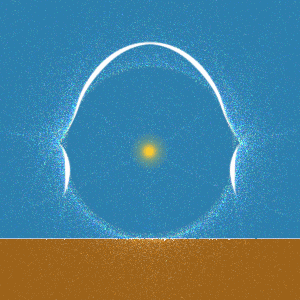Lowitz arcs are a group of relatively rare halos that appear outside the
22° ring. Their shape is highly dependent on the sun's altitude. EE14 refers to Lowitz arcs on the left side, EE15 on the right side, and EE16 the occurrence on both sides.
On June 18, 1790, Johann Tobias Lowitz observed in St. Petersburg colored short arc pieces which extended from the
parhelia colored diagonally upwards and downwards to the 22° ring . In today's halo key, this historical sighting falls into the category EE16B (bilateral lower lateral Lowitz arcs).
Around 1980, Robert Greenler conducted numerical simulations of these arcs, additionally identifying two further ray paths. These in the simulation created new halos not yet observed.
On August 11, 1985, Jens Fröhlich observed a reddish arc in Knau (Thuringia) that extended from the vertex of the
Parry arc bilaterally downwards into the 22° ring. After further observations in Germany and Finland, this was identified in comparison with Greenler's predictions and additional simulations by Eberhard Tränkle in the mid-1990s as one of the previously unknown Lowitz arcs, whereupon it was named the "upper circular Lowitz arc" (EE14C-16C) due to its shape.
In English literature, influenced by Greenler's theory, Lowitz arcs are classified according to ray paths into upper (U), middle (M), and lower (L) Lowitz arcs. According to this theory, all Lowitz arcs cross a 22° parhelion (or both).
However, the classification of the Arbeitskreis Meteore e.V. is less oriented towards theory and more towards the appearance of halos in nature. This ensures continuity within the statistics, independent of theoretical developments. In this classification scheme, there are initially the
upper lateral Lowitz arcs (EE14A-16A) as connections starting from the 22° parhelion slanting upwards to the 22° halo. These are parts of the arc belonging to the U-ray path. The arcs that tangentially run downward from the parhelion to the 22° halo are referred to as
lower lateral Lowitz arcs (EE14B-16B) and are generated by the L-ray path. Both halo subtypes (A and B) can, when extraordinarily well developed, extend "backwards" beyond the parhelia downwards or upwards.
The following photo shows the Lowitz arcs in the area of the left parhelion. It was taken on
01.10.2014 by Thomas Klein in Miesbach.
The subcategory EE14E-16E forms the reflected Lowitz arcs, also known as "Schulthess's arcs." These arise analogously to the above-described "normal" Lowitz arcs, but with an additional reflection on a prism deck surface. Thus, there are also three possible ray paths (RU for "reflected upper", RM and RL), which now intersect not in the parhelion, but in the subparhelion. Observing this intersection would, however, require sufficient crystals below the horizon. Due to the extreme rarity of this halo subtype, further subdivision is omitted in the context of the halo key.
Lowitz arcs are primarily observed at low solar altitudes below 35°, with reflected Lowitz arcs mostly under 20°. The side arc pieces are most frequently seen. The upper circular Lowitz arc is rare, and the even rarer reflected Lowitz arcs occur mainly in ice fog.

